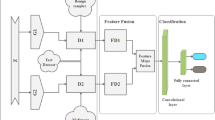Abstract
Nodule CT image synthesis is effective as a data augmentation method for deep learning tasks about lung nodules. To advance the realistic malignant/benign lung nodule synthesis, the conditional Generative Adversarial Networks have been widely adopted. In this paper, we argue about an issue in the existing technique for class-aware nodule synthesis: the class-aware controllability of semantic features. To address this issue, we propose a adversarial lung nodule synthesis framework based on conditional Generative Adversarial Networks and class-aware multi-window semantic feature learning. By learning semantic features from multi-window CT images, our framework can generate realistic nodule CT images, and has better controllability of class-aware nodule features. Our framework provides a new perspective for nodule CT image synthesis that has never been noticed before. We train our framework on the public dataset LIDC-IDRI. Our framework improves the malignancy prediction F1 score by more than 3% and shows promising results as a solution for lung nodule augmentation. The source code can be found at https://github.com/qiuliwang/CA-MW-Adversarial-Synthesis.
This research was supported in part by the National Natural Science Foundation of China under Grant 61772093, in part by the National Key R&D Project of China under Grant 2018YFB2101200, and in part by the Chongqing Major Theme Projects under Grant cstc2018jszx-cyztzxX0017.
Access this chapter
Tax calculation will be finalised at checkout
Purchases are for personal use only
Similar content being viewed by others
References
Abadi, M., Agarwal, A., Barham, P., et al.: TensorFlow: large-scale machine learning on heterogeneous distributed systems. arXiv preprint arXiv:1603.04467 (2016)
Armato III, S.G., McLennan, G., Bidaut, L., et al.: The lung image database consortium (LIDC) and image database resource initiative (IDRI): a completed reference database of lung nodules on CT scans. Med. Phys. 38(2), 915–931 (2011)
Bankier, A.A., MacMahon, H., Goo, J.M., et al.: Recommendations for measuring pulmonary nodules at CT: a statement from the Fleischner Society. Radiology 285(2), 584–600 (2017)
Chuquicusma, M.J., Hussein, S., Burt, J., et al.: How to fool radiologists with generative adversarial networks? A visual turing test for lung cancer diagnosis. In: ISBI 2018, pp. 240–244. IEEE (2018)
Costa, P., Galdran, A., Meyer, M.I., et al.: End-to-end adversarial retinal image synthesis. IEEE T. Med. Imaging 37(3), 781–791 (2017)
Goodfellow, I., Pouget-Abadie, J., Mirza, M., et al.: Generative adversarial nets. In: NeurIPS 2014, pp. 2672–2680 (2014)
Gu, S., Bao, J., Yang, H., et al.: Mask-guided portrait editing with conditional GANs. In: CVPR 2019, pp. 3436–3445. IEEE (2019)
Isola, P., Zhu, J.Y., Zhou, T., et al.: Image-to-image translation with conditional adversarial networks. In: CVPR 2017, pp. 1125–1134. IEEE (2017)
Mirza, M., Osindero, S.: Conditional generative adversarial nets. arXiv preprint arXiv:1411.1784 (2014)
Okada, M., Nishio, W., Sakamoto, T., et al.: Correlation between computed tomographic findings, bronchioloalveolar carcinoma component, and biologic behavior of small-sized lung adenocarcinomas. J. Thorac. Cardiovasc. Surg. 127(3), 857–861 (2004)
Qi, D., Hao, C., Yu, L., et al.: Multilevel contextual 3-D CNNs for false positive reduction in pulmonary nodule detection. IEEE Trans. Bio-Med. Eng. 64(7), 1558–1567 (2016)
Radford, A., Metz, L., Chintala, S.: Unsupervised representation learning with deep convolutional generative adversarial networks. arXiv preprint arXiv:1511.06434 (2015)
Ronneberger, O., Fischer, P., Brox, T.: U-Net: convolutional networks for biomedical image segmentation. In: Navab, N., Hornegger, J., Wells, W.M., Frangi, A.F. (eds.) MICCAI 2015. LNCS, vol. 9351, pp. 234–241. Springer, Cham (2015). https://doi.org/10.1007/978-3-319-24574-4_28
Shaham, T.R., Dekel, T., Michaeli, T.: SinGAN: learning a generative model from a single natural image. In: ICCV 2019, pp. 4570–4580. IEEE (2019)
Shen, S., Han, S.X., Aberle, D.R., et al.: An interpretable deep hierarchical semantic convolutional neural network for lung nodule malignancy classification. Expert Syst. Appl. 128, 84–95 (2019)
Wu, B., Zhou, Z., Wang, J., et al.: Joint learning for pulmonary nodule segmentation, attributes and malignancy prediction. In: ISBI 2018, pp. 1109–1113. IEEE (2018)
Xu, Z.: Tunable CT lung nodule synthesis conditioned on background image and semantic features. In: Burgos, N., Gooya, A., Svoboda, D. (eds.) SASHIMI 2019. LNCS, vol. 11827, pp. 62–70. Springer, Cham (2019). https://doi.org/10.1007/978-3-030-32778-1_7
Yang, J., Liu, S., Grbic, S., et al.: Class-aware adversarial lung nodule synthesis in CT images. In: ISBI 2019, pp. 1348–1352. IEEE (2019)
Yi, X., Walia, E., Babyn, P.: Generative adversarial network in medical imaging: a review. Med. Image Anal. 58, 101552 (2019)
Author information
Authors and Affiliations
Corresponding author
Editor information
Editors and Affiliations
Rights and permissions
Copyright information
© 2020 Springer Nature Switzerland AG
About this paper
Cite this paper
Wang, Q., Zhang, X., Chen, W., Wang, K., Zhang, X. (2020). Class-Aware Multi-window Adversarial Lung Nodule Synthesis Conditioned on Semantic Features. In: Martel, A.L., et al. Medical Image Computing and Computer Assisted Intervention – MICCAI 2020. MICCAI 2020. Lecture Notes in Computer Science(), vol 12266. Springer, Cham. https://doi.org/10.1007/978-3-030-59725-2_57
Download citation
DOI: https://doi.org/10.1007/978-3-030-59725-2_57
Published:
Publisher Name: Springer, Cham
Print ISBN: 978-3-030-59724-5
Online ISBN: 978-3-030-59725-2
eBook Packages: Computer ScienceComputer Science (R0)





